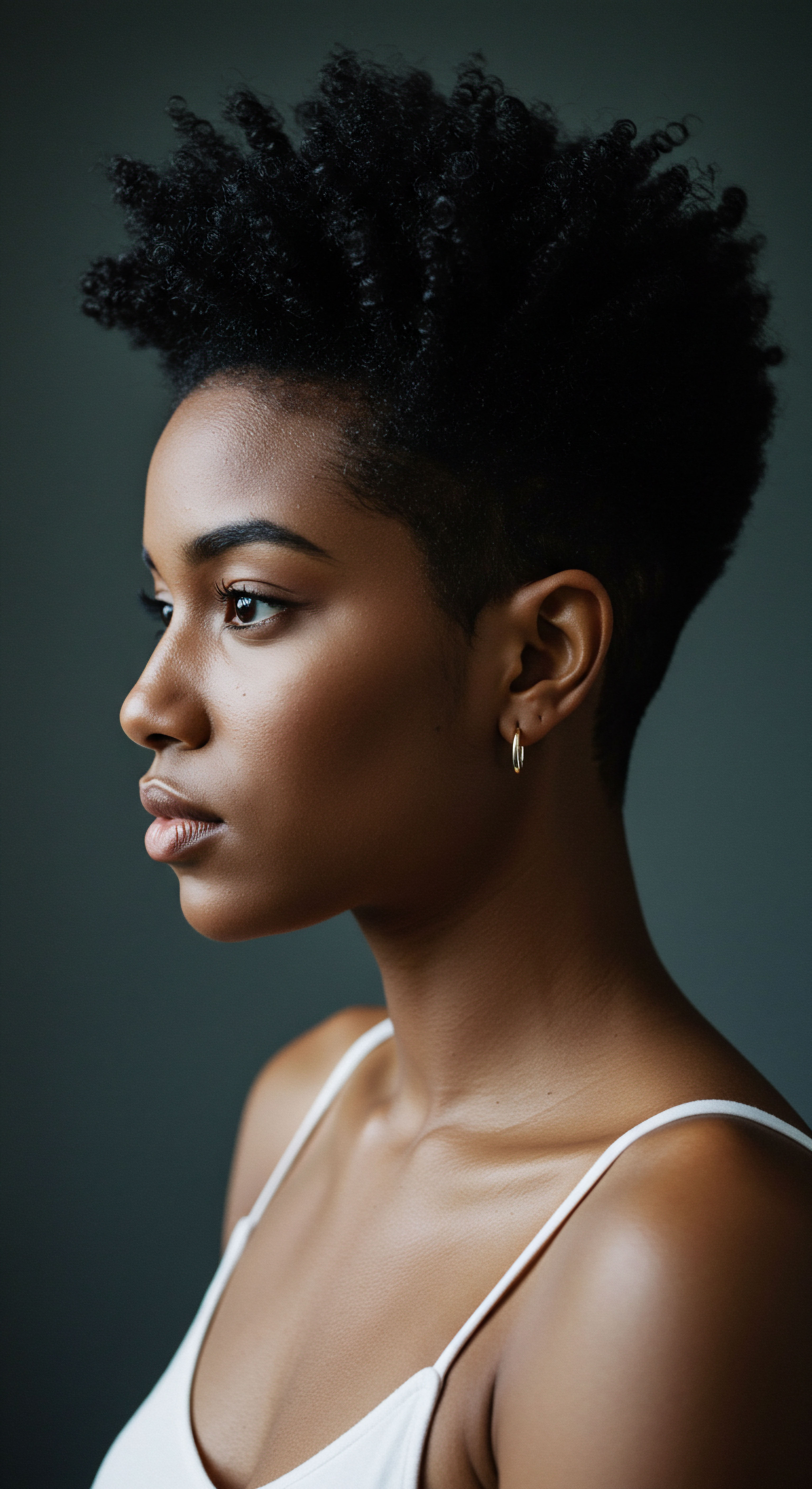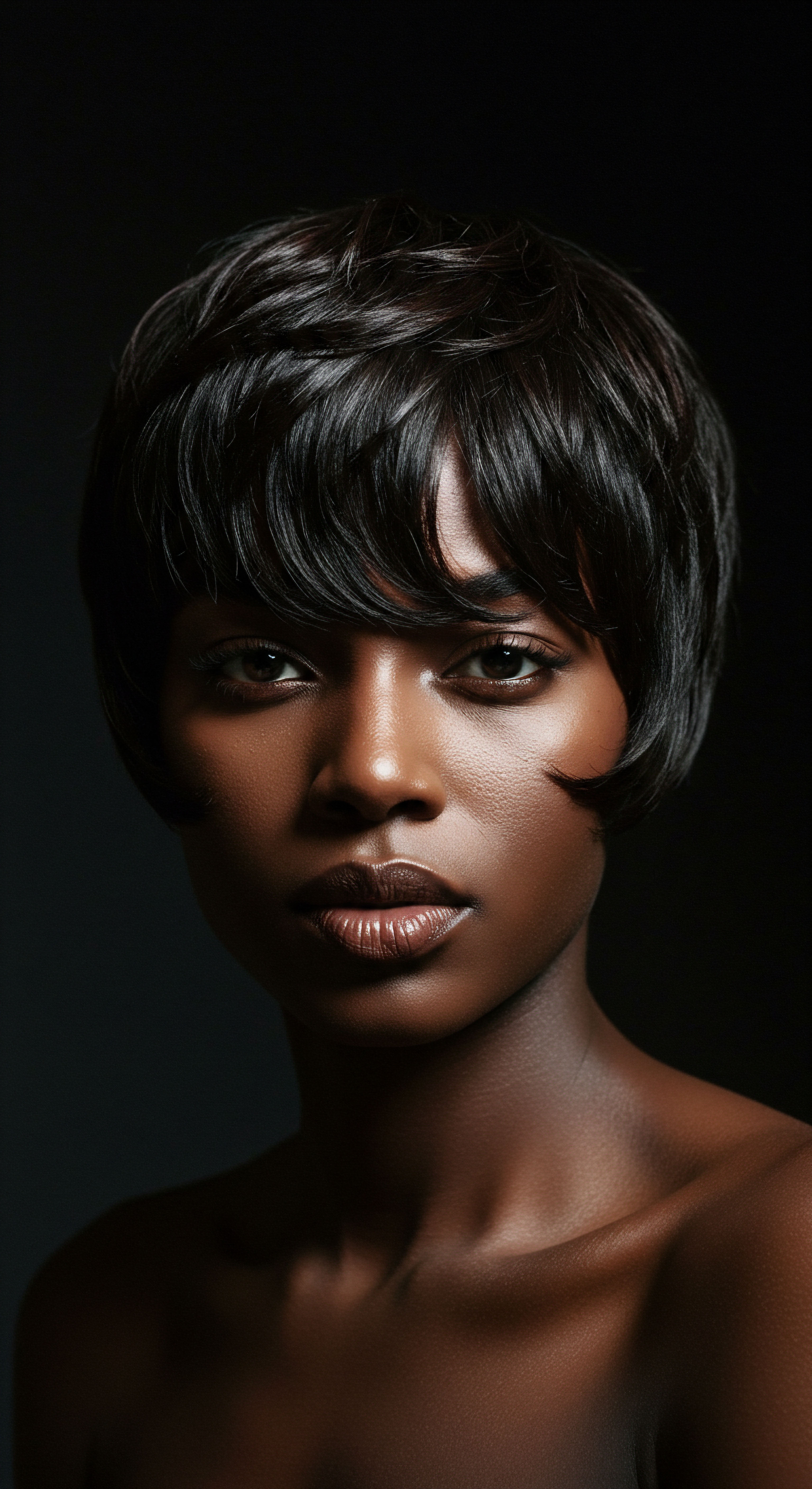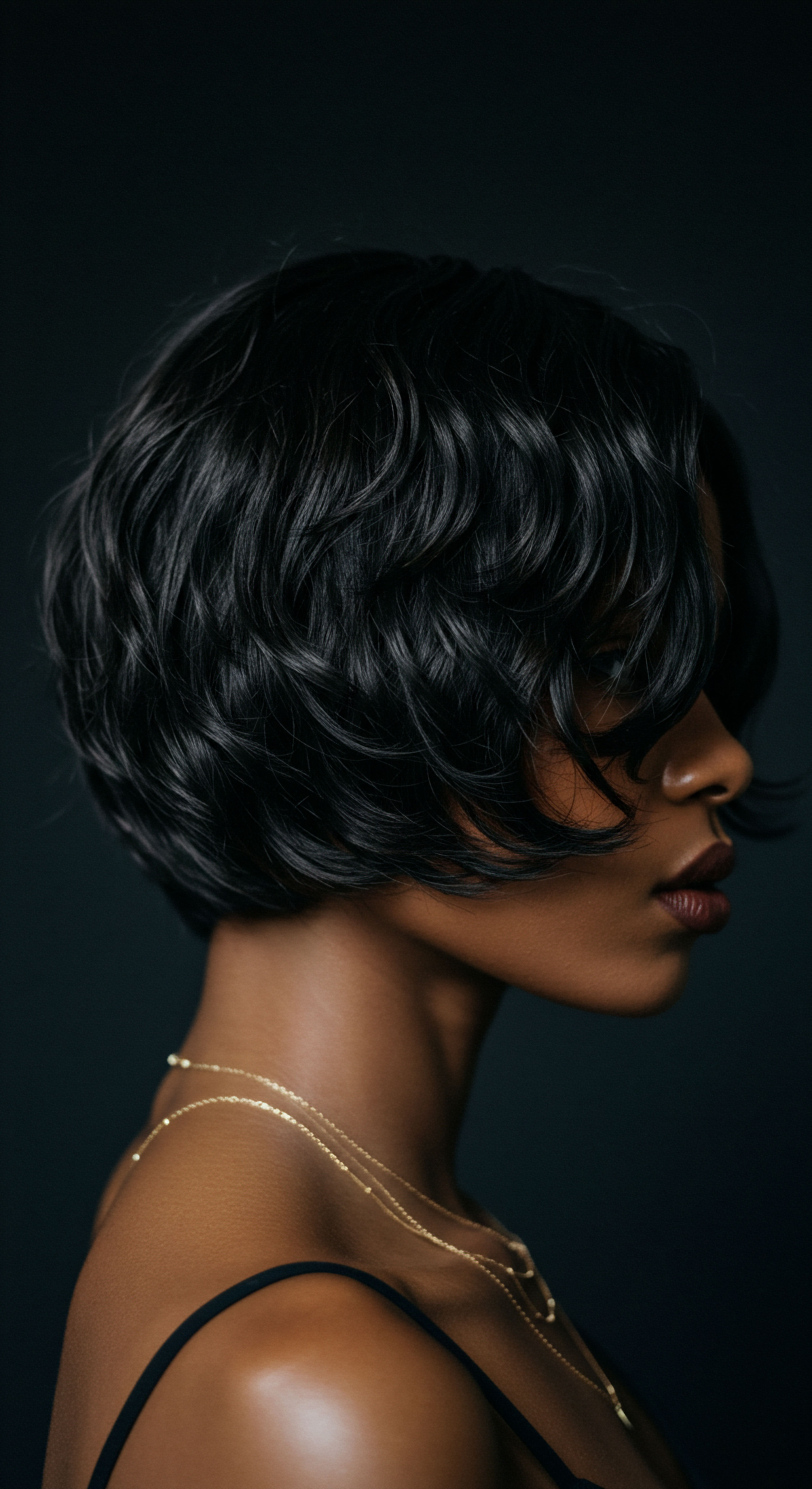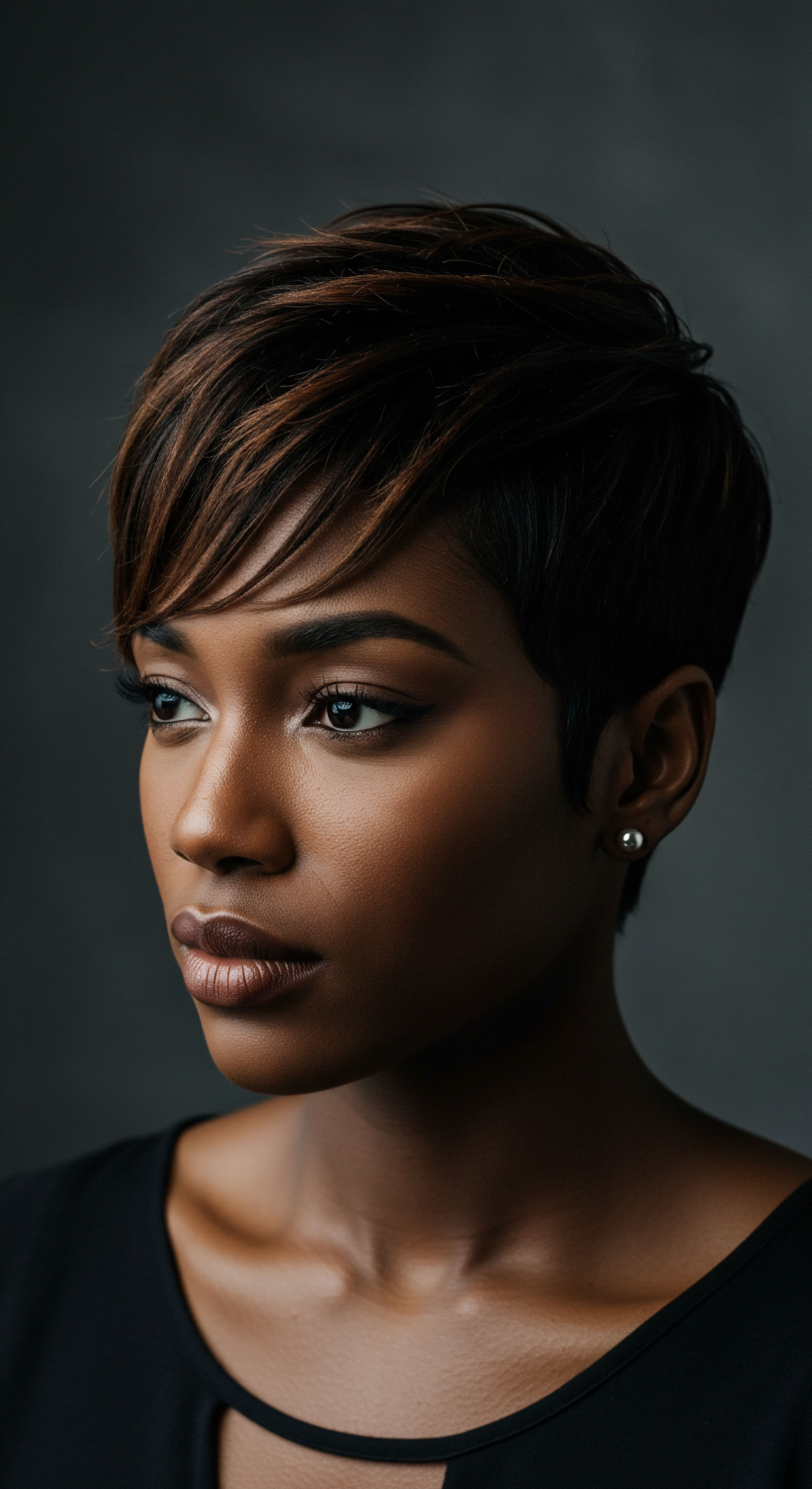
Roots
The quiet hum of life, often overlooked in its daily rhythms, holds profound truths about who we are and how we shape the world around us. Consider the simple strand of hair, particularly textured hair, a filament of identity and heritage. For generations, the stories woven into these coils and kinks have been more than just personal adornment; they have been silent declarations, reflections of cultural lineage, and powerful statements in a world that often sought to diminish their innate glory. This deep connection, rooted in ancestral practices and lived experiences, forms the elemental ground from which a significant cultural awakening has sprung.
This movement, seemingly focused on personal aesthetics, possesses an astonishing capacity to reshape financial landscapes and legislative frameworks. It asks us to look beyond the superficial, to understand how a return to what is authentic can ripple through the very structures of our societies.

The Intricacies of Textured Hair
Understanding textured hair begins with its very structure, a microscopic world of helixes and bonds that distinguish it from straighter hair types. The follicle, the tiny organ from which each strand grows, plays a primary role in determining curl pattern. In textured hair, the follicle is often elliptical or flattened, causing the hair shaft to grow in a curved or helical manner. This unique shape leads to the characteristic bends and twists, influencing how light reflects off the strand, how moisture is retained or lost, and how easily products distribute.
The cuticle, the outermost layer of the hair, composed of overlapping scales, tends to be more lifted in textured hair, which can contribute to its natural volume but also its susceptibility to moisture loss if not properly cared for. The cortex, the inner layer, provides strength and elasticity, while the medulla, the innermost core, may be discontinuous or absent in finer strands.
These anatomical distinctions underpin the diverse classifications we observe. While no single system perfectly captures the spectrum of textured hair, various frameworks have emerged to help individuals and professionals categorize and understand different curl patterns. The most widely recognized system, though sometimes critiqued for its limitations, assigns numbers and letters (e.g. 3A, 4C) to describe the tightness and shape of curls, coils, and kinks.
However, true comprehension extends beyond a simple numerical assignment; it embraces the hair’s Density, its Porosity (its ability to absorb and retain moisture), and its Elasticity (its capacity to stretch and return to its original state). These characteristics collectively dictate the most suitable care practices and product choices.
The inherent qualities of textured hair, from its unique follicular shape to its varied porosity, serve as the foundational knowledge guiding the natural hair movement’s evolution.

What Are the Fundamental Elements of Textured Hair?
The essential lexicon of textured hair has developed alongside the movement itself, providing a shared language for individuals navigating their personal hair journeys. Terms such as Shrinkage, referring to the apparent reduction in hair length when wet or dry due to the coil pattern, or Co-Washing, the practice of cleansing hair with conditioner instead of shampoo, have become commonplace. Understanding these terms empowers individuals to better communicate their needs and select appropriate treatments.
The journey of hair growth itself, cycling through anagen (growth), catagen (transitional), and telogen (resting) phases, is influenced by a myriad of factors, including genetics, nutrition, hydration, and even stress. A balanced diet rich in vitamins and minerals, adequate water intake, and mindful stress management all contribute to a healthier growth cycle.
The economic impact of this foundational understanding cannot be overstated. As more individuals began to recognize and celebrate their natural textures, the demand for products tailored to these specific needs soared. This shift created a fertile ground for innovation, prompting both established beauty corporations and burgeoning independent brands to develop specialized shampoos, conditioners, stylers, and tools.
The market for chemical relaxers, once a dominant force, began a steady decline, directly correlating with the ascent of natural hair care lines. This redirection of consumer spending from chemical alteration to natural enhancement represents a significant economic recalibration, reflecting a collective redefinition of beauty standards.

The Shift in Haircare Lexicon and Consumption
The language we use to describe textured hair has undergone a profound transformation. What once might have been considered “unruly” or “difficult” is now celebrated as “coily,” “kinky,” or “curly,” each term carrying a sense of specific beauty and scientific understanding. This linguistic evolution is not merely semantic; it signals a fundamental change in perception, directly influencing consumer behavior. When individuals possess the vocabulary to articulate their hair’s needs, they become more discerning consumers, seeking out products that align with their specific porosity, density, and curl pattern.
- Porosity ❉ The hair’s capacity to absorb and retain moisture, influencing product absorption.
- Density ❉ The number of individual hair strands on the scalp, affecting volume and styling.
- Elasticity ❉ The hair’s ability to stretch and return to its original length without breaking, indicating its health.
This discerning consumer base has directly fueled the growth of specialized product lines. Brands now formulate for “low porosity,” “high porosity,” “fine strands,” or “thick coils,” recognizing the vast spectrum within textured hair. This granular approach to product development represents a significant departure from the more generalized offerings of the past, creating niche markets within the broader beauty industry. The economic consequence is a more diverse marketplace, one that rewards brands capable of delivering targeted solutions and authentic connections with their consumer base.

Ritual
Stepping into the realm of daily hair care, we encounter a vibrant world of practices and methods, each holding a particular wisdom. For those with textured hair, this realm is not merely about maintenance; it is a space of discovery, personal expression, and often, quiet resistance. The daily or weekly rituals of cleansing, conditioning, and styling are deeply personal, yet they collectively form a powerful current within the natural hair movement.
This section explores the tangible aspects of this movement, the techniques and tools that have reshaped beauty routines and, in turn, have begun to ripple through economic and policy spheres. It is here that the personal choices of millions coalesce into observable market shifts and legislative considerations.

The Art of Protective Styling
Protective styles stand as a cornerstone of textured hair care, offering respite from daily manipulation while promoting length retention and overall hair health. These styles, which include a vast array of braids, twists, locs, and buns, are not new inventions; their roots stretch back through centuries of African and diasporic traditions, serving functions beyond mere aesthetics—signaling marital status, tribal affiliation, or social standing. Today, their resurgence carries both cultural significance and substantial economic weight.
The demand for skilled braiders, locticians, and natural hair stylists has created a thriving sector within the beauty service industry. Salons specializing in textured hair have seen significant growth, and independent stylists often command considerable rates for their expertise.
The economic impact extends to the retail sector as well. The creation and maintenance of these styles necessitate specific products ❉ braiding hair, styling gels, setting lotions, and scalp oils. This has spurred a distinct market for these items, with both established and emerging brands vying for consumer loyalty.
The global market for hair extensions and wigs, much of which caters to textured hair styles, is a multi-billion dollar industry. This demand influences international trade, supply chains for raw materials (both synthetic and human hair), and labor practices in manufacturing regions.

How Do Styling Practices Shape Economic Landscapes?
Beyond protective styles, natural styling and definition techniques have gained immense popularity. The Wash-And-Go, Twist-Out, and Braid-Out are celebrated methods for defining natural curl patterns, each requiring specific product combinations and application methods. The rise of these techniques has directly correlated with the growth of specific product categories ❉ curl creams, gels, custards, and leave-in conditioners designed to enhance and hold natural texture. This has led to a proliferation of product innovation, with brands constantly refining formulas to meet the diverse needs of different curl types and preferences.
The shift away from chemical relaxers represents one of the most profound economic transformations within the textured hair market. For decades, relaxers dominated the Black haircare industry, generating substantial revenue for large corporations. The natural hair movement has dramatically altered this landscape.
| Product Category Relaxers |
| Trend (2008-2013) Sales plummeted by 26% |
| Economic Impact Significant revenue loss for traditional manufacturers; decline in chemical salon services. |
| Product Category Natural Hair Products |
| Trend (2008-2013) Sales soared |
| Economic Impact Increased revenue for new and existing brands; rise of specialized product lines. |
| Product Category Heat Styling Tools |
| Trend (2008-2013) Shift towards safer, less damaging options |
| Economic Impact Innovation in flat irons, blow dryers; growth in heat protectant sales. |
| Product Category This period marked a substantial redirection of consumer spending within the beauty sector. |
This decline in relaxer sales is a direct consequence of the natural hair movement’s advocacy for embracing natural texture. Consequently, the market for heat styling and thermal reconditioning has also evolved. While some individuals still opt for occasional heat styling to achieve straightened looks, there is a pronounced emphasis on a safety-first approach. This has spurred innovation in heat protectants, ceramic and tourmaline styling tools, and techniques that minimize damage.
The complete textured hair toolkit now includes a specific array of combs (wide-tooth, detangling), brushes (denman, paddle), and accessories (satin scrunchies, bonnets) that cater to the delicate nature of textured strands. Each of these items represents a distinct market segment, contributing to the overall economic growth fueled by the movement.
The practical applications of textured hair care, from protective styles to product selection, have reshaped beauty industry practices and generated new avenues for economic activity.

The Rise of the Textured Hair Entrepreneur
The shift in consumer preferences has not merely altered the product offerings of existing companies; it has catalyzed a wave of entrepreneurship within the textured hair community. Many individuals, frustrated by the lack of suitable products or culturally sensitive services, took it upon themselves to create their own solutions. This led to the proliferation of small, independent, often Black-owned beauty brands. These businesses, frequently starting online or through grassroots efforts, have cultivated a loyal following by directly addressing the needs and concerns of the textured hair consumer.
This phenomenon extends beyond product creation to the service sector. Natural hair stylists, who once might have struggled to find mainstream salon employment, now operate thriving independent businesses, often specializing in specific techniques like loc maintenance, protective styling, or curl cutting. This economic independence represents a significant gain, providing opportunities for wealth creation within communities that have historically been underserved by the broader beauty industry. The direct economic benefit of this entrepreneurial spirit is evident in the growth of Black-owned beauty supply stores, online retailers, and specialized salons, creating jobs and fostering local economic development.

Relay
As we delve deeper into the currents set in motion by the natural hair movement, we discern not merely shifts in personal preference, but profound realignments within economic structures and the very fabric of public policy. This is where the individual journey of hair acceptance intersects with the broader societal landscape, prompting a re-evaluation of long-held norms and generating tangible effects on commerce and governance. The story here is one of interconnectedness, where biological realities, cultural affirmations, and market forces converge to create a powerful impetus for change. It is a testament to how a collective redefinition of beauty can cascade through industries and legislative bodies, revealing the less apparent complexities of our world.

Policy and the Market ❉ A Symbiotic Relationship
The impact of the natural hair movement on public policy is perhaps its most compelling and least commonly discussed facet. The most prominent example is the legislative effort to prohibit discrimination based on hair texture and protective hairstyles. The CROWN Act (Creating a Respectful and Open World for Natural Hair), originating in California in 2019, has since been adopted by numerous states and municipalities across the United States.
This legislation, while fundamentally a civil rights measure, carries significant economic implications. By legally affirming the right to wear natural hair in schools and workplaces, it directly influences consumer confidence and spending patterns.
Consider the subtle, yet powerful, economic validation that comes with such policy. When individuals no longer fear professional repercussions for their natural hair, they are more likely to invest in natural hair care products and services, rather than spending on chemical treatments or styling that alters their texture. This legislative backing provides a stable environment for the natural hair market to flourish, reducing perceived risks for entrepreneurs and investors in this sector. It signals to corporations that natural hair is not a niche trend but a legitimate and protected form of expression, potentially influencing corporate diversity initiatives, marketing budgets, and product development pipelines.
The legislative recognition of natural hair as a protected characteristic profoundly impacts consumer confidence and market stability within the beauty industry.

Can Public Policy Influence Consumer Spending?
The movement’s economic impact is also evident in the changing dynamics of the beauty supply chain and ingredient sourcing. As demand for products free from harsh chemicals and rich in natural components has surged, manufacturers have had to adapt. This has led to an increased focus on sourcing ingredients like shea butter, coconut oil, and aloe vera, often from global suppliers, sometimes prompting discussions around ethical sourcing and fair trade practices. This shift can influence agricultural economies in producer countries and promote more sustainable practices within the beauty industry.
A less commonly discussed but equally significant economic consequence is the redirection of consumer spending within the Black haircare market. Historically, despite Black consumers accounting for a disproportionately high percentage of overall haircare spending, a substantial portion of this expenditure did not flow to Black-owned businesses. A 2018 Nielsen report highlighted that Black consumers spent over $473 million on hair care products. While this figure is substantial, the more profound economic shift lies in the increasing market share captured by independent, often Black-owned, natural hair brands.
This represents a tangible economic transfer, moving wealth from traditional, often non-Black-owned corporations towards businesses directly rooted in the community, thereby creating new avenues for entrepreneurship and local economic development. This shift signifies a powerful act of economic self-determination, building community wealth and fostering a more equitable distribution of economic benefit within the beauty sector.
The rise of specialized product categories, such as those catering to specific porosity levels or scalp conditions, speaks to a deepening understanding of textured hair needs. This granularity in product development is a direct response to consumer demand for personalized solutions, moving beyond generic “ethnic hair” labels. This has fostered a more competitive and innovative market, pushing brands to invest in research and development to create highly targeted and effective formulations.
The cultural validation provided by the natural hair movement also extends to the broader wellness sphere. The idea that hair health is interconnected with overall well-being has led to a greater interest in holistic approaches. This includes dietary considerations, stress reduction techniques, and the use of supplements aimed at promoting hair growth and vitality. This broadens the economic scope of the movement, connecting it to the health food industry, wellness retreats, and even the mental health sector, as self-acceptance and body positivity are increasingly recognized as components of overall health.
- Policy Impact ❉ Legislative acts like the CROWN Act legitimize natural hair, influencing corporate marketing and investment.
- Market Reallocation ❉ Consumer spending shifts from traditional brands to independent, often Black-owned, natural hair businesses.
- Supply Chain Changes ❉ Increased demand for natural ingredients prompts shifts in sourcing and ethical considerations.

The Global Reach of Textured Hair Influence
The natural hair movement, while having strong roots in the African diaspora, has extended its influence globally. In various parts of the world, individuals of African descent are reclaiming their natural textures, leading to similar economic and cultural shifts. This global resonance creates international trade opportunities for natural hair products and services, fostering cross-cultural exchange around beauty standards and self-acceptance. The movement serves as a powerful example of how cultural shifts, driven by individual choices, can collectively reshape global markets and inspire legislative changes far beyond their point of origin.
The advocacy efforts for policy change often involve significant lobbying and community organizing. These efforts, while primarily focused on social justice, require financial resources and strategic planning, contributing to the “policy economy” around civil rights. The success of the CROWN Act, for instance, has demonstrated the power of collective action in translating cultural shifts into legal protections, which in turn reinforce the economic viability of the natural hair market. This cyclical relationship underscores the deep and often subtle ways in which cultural movements, economic markets, and public policy are inextricably linked.

Reflection
The quiet assertion of wearing one’s hair in its natural state, once a deeply personal choice, has unfurled into a vibrant cultural phenomenon with tangible repercussions far beyond the individual mirror. It has reshaped industries, sparked legislative action, and challenged long-held notions of beauty and professionalism. This movement reminds us that authenticity holds a quiet power, capable of redirecting economic currents and influencing the very laws that govern our collective lives.
It is a testament to the profound interconnectedness of personal identity, cultural heritage, and the broader societal landscape, urging us to consider how seemingly small shifts in perception can ultimately lead to monumental transformations in the world around us. The story of natural hair is still being written, a continuous affirmation of identity and a testament to the enduring spirit of self-acceptance.

References
- Byrd, A. D. & Tharps, L. (2014). Hair Story ❉ Untangling the Roots of Black Hair in America. St. Martin’s Griffin.
- Nielsen. (2018). Black Impact ❉ Consumer Categories Where Black Consumers Move Markets.
- Patton, T. O. (2006). Pushing Boundaries ❉ My Life with African-American Hair. University of Georgia Press.
- Banks, I. (2000). Hair Matters ❉ Beauty, Power, and Black Women’s Consciousness. New York University Press.
- Cobb, L. (2019). The CROWN Act ❉ A Comprehensive Analysis of Its Impact on Workplace Discrimination. Journal of Law and Society, 46(3).
- Hunter, L. (2011). Black Hair, Black Skin, Black Beauty ❉ The Politics of Appearance in the African Diaspora. Palgrave Macmillan.
- Mintel. (2017). Ethnic Haircare US.
- Mercer, K. (1994). Welcome to the Jungle ❉ New Positions in Cultural Studies. Routledge.